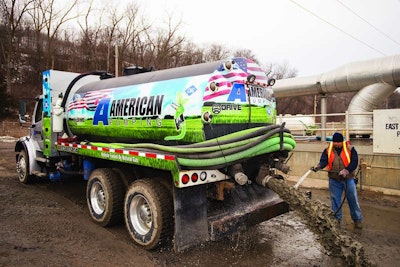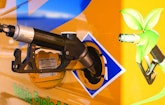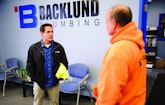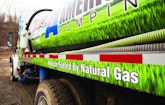
Interested in Pumps?
Get Pumps articles, news and videos right in your inbox! Sign up now.
Pumps + Get AlertsTo increase market share in the grease trap and septic pumping market in metropolitan Omaha, Nebraska, Chris and Mark Roseland — the owners of American Pumping — figured they’d have to operate leaner than and differentiate from competitors, as well as make a bit of a marketing splash.
They accomplished all three goals by making a significant investment in new technology that has reduced operating costs and earned the company plenty of free publicity: vacuum trucks powered by compressed natural gas (CNG).
The company’s two pump trucks feature Freightliner M2 chassis equipped with 2,800- and 3,800-gallon steel tanks and Jurop/Chandler pumps. One of the trucks also sports two 100-gallon water tanks and a Hotsy hot-water unit that makes short work of grease clogs, says Chris Roseland.
But the most noteworthy aspect is the Cummins Westport ISLG natural gas engines (320 hp), which will reduce the company’s operating expenses. The natural gas conversions, performed by Truck Center Companies, are relatively simple: The gas tank and fuel delivery system is replaced with a CNG tank and a new fuel delivery system. Then, another conversion kit enables the original gas engine to run on natural gas, Roseland says.
The Roselands bought American Pumping in 2012 and made it a subsidiary of a larger company they own, Backlund Plumbing, which Mark and his wife, Sally, bought in 1987. The Roselands wanted to further diversify Backlund Plumbing’s business base, which includes residential, commercial and municipal drain cleaning; residential and commercial plumbing; hydroexcavating; and water and sewer line installations.
“We basically grew as our customers’ needs grew,” says Chris Roseland, a master plumber who joined the company in 1994. A good example is outside utility installations, such as new waterlines — work the company didn’t do until 2008, based on growing demand from customers. That required a significant investment in tractors and backhoes needed to install fire lines and storm and sanitary lines.
“There was a huge learning curve in how to do outside utilities,” he notes. “But we took our experienced plumbers and added utilities to their scope of work. They took OSHA confined-space entry classes and learned safe excavation techniques — things like what equipment to use in what situation, how to use it, and proper compaction and backfilling techniques.”
QUALITY CONTROL
Backlund Plumbing also diversified to reduce its reliance on subcontractors. By offering as many services in-house as possible, the Roselands felt they could better control the quality of work as well as job schedules, unhindered by subs who might show up later than expected.
“If someone calls with a problem at midnight, we show up with all our vehicles and we don’t have to wait for a sub to show up,” Roseland adds. “We run a 24-hour operation — no answering service. If the phone rings at 2 a.m., we answer it.
Same-day service is a huge must in our world. And we also have the equipment ready to handle virtually any problem; we’re a one-stop shop for plumbing, pumping, utility work and hydroexcavating. If people asked us to paint their house, we’d probably paint their house. … We’ll literally do anything.”
Moreover, offering a variety of services avoids the all-eggs-in-one-basket problem that leaves some companies vulnerable to market downturns, he says. The strategy has worked well so far; since 1987, Backlund Plumbing has grown from a small service shop with just three employees to a multimillion-dollar-a-year company with 65 employees and a large fleet of vehicles and equipment.
“Utility repairs and plumbing repairs definitely feed off of our grease trap and septic maintenance business because of inspections,” Roseland explains. “For instance, we may inspect a septic tank and find the leachfield isn’t draining properly because the lines are clogged. It works the same way with grease traps. … A lot of grease traps we clean out also require line jetting.
“The fact that we utilize Spartan trailer-mounted water jetters to jet and wash down grease traps helps separate us from other companies,” he continues. “With all of our sewer cleaning equipment, we can do a better job than a guy with just a septic truck with a pump at his disposal.’’
Those synergies also work in reverse, he says, noting that plumbing repairs sometimes lead to grease trap or septic tank work for American Pumping. In addition, competing plumbing firms sometimes hire American Pumping when they unexpectedly encounter jobs that require grease trap or septic tank cleaning.
“That’s why we kept the name American Pumping,” Roseland explains. “If a plumbing company that maintains restaurants wants to subcontract grease trap work, for example, we figured they wouldn’t want a truck pulling up on the job site with the name of a competing plumber on the truck.”
ALL IN WITH NATURAL GAS
The Roselands were already familiar with the dynamics of natural-gas-powered trucks. In 2012, the company converted 10 Ford Econoline service vans, used for drain cleaning and plumbing work, to natural gas. Today, natural gas also powers seven Ford Transit vans, two Dodge 2500 flatbed delivery trucks, three Freightliner FL70 service trucks, and two dump trucks featuring Freightliner FL70 chassis and (in-house built) 7-cubic-yard dump bodies.
High fuel prices played a key role in the decision to convert to natural gas. In 2012, the average price for a gallon of gasoline nationwide hovered around $3.60. “At the time, we were doing work for the city’s Metropolitan Utility District (MUD) and I noticed they were converting their vehicles,” Roseland recalls. “So I inquired about it.”
Back then, CNG cost just $1.70 a gallon. In addition, natural gas prices historically aren’t subject to the volatile swings commonly seen in gasoline prices. And while the conversion price was expensive — about $12,000 per service van — MUD was offering a 50 percent rebate. That sealed the deal, he says.
“With financial assistance from the rebates, our break-even point was running 3,000 gallons (of CNG) through the vehicles,” Roseland explains. “Each van saved about $4,000 the first year through reduced fuel costs. I’d say 90 percent of those first 10 conversions paid for themselves within the first two or three years.”
There was a strong case for converting the septic pump trucks to natural gas because the city of Omaha requires contractors to dispose of all grease trap and septic waste at the city’s main treatment plant. In some instances, that means route drivers must make a 40- or 50-mile round-trip from Omaha to rural customers and back to the treatment plant. “So CNG vehicles allow us to offer pumping services at a lower cost,” Roseland points out. “The more miles the trucks travel, the more money we save.”
STILL REAPING SAVINGS
Gas has fluctuated downward and back up a bit, so the fuel savings aren’t as dramatic. But Roseland points out that since the vans’ conversions, the company also converted the two Freightliner dump trucks and other vehicles that used diesel fuel, which remains more expensive than CNG.
The cost of larger CNG-powered vehicles, such as the Freightliner dump trucks (which come with John Deere or Cummins CNG engines), is about $60,000 more than for a conventional truck. As such, the payback period is longer — about two years, he notes. “When diesel is at $4 a gallon and CNG is $2 a gallon, we might save up to $250 a day,” he explains.
“In my opinion, fuel prices eventually are going to go back up,” Roseland continues. “Our vehicles have a seven- or eight-year life cycle, so we’re betting that fuel costs will average out higher in the next seven years.” In the short term, he remains undaunted by lower fuel prices; the company plans to buy and convert five more Transit vans in 2016, he says. “We’ve never lost money (using natural gas over gasoline).”
Backlund’s revenues have increased since the natural gas conversions, and Roseland attributes much of it to the company’s ability to brand itself as a “green,” eco-conscious business. “I can verify that because we’ve only promoted it on our vinyl vehicle wraps, and when people call, they usually ask about the CNG trucks,” he says. “They notice that we’ve done it. Our employees tell me that customers are always asking how it works. I think that if we’re on par with a competitor price-wise, we get chosen because we’re ‘greener.’”
Roseland says the use of natural gas doesn’t affect engine performance. “Three-hundred hp on (an engine using) diesel fuel is the same as 300 hp with natural gas,” he says. The only difference he’s noticed is that the natural-gas-powered engines seem to run a little hotter and burn a little more oil than conventional diesel- or gasoline-powered engines.
There is one drawback to CNG-powered vehicles: Fueling stations are scarce. Roseland says the company is fortunate because there are two CNG stations within a mile of the company’s headquarters. In addition, all the CNG vehicles have only a 250-mile range, so drivers must always be aware of their proximity to fueling stations. “But they’re adding more refueling stations every year,” he notes.
FILLING THE GARAGE
As demand for drain cleaning services grew, so did the company’s roster of equipment. Today, the company owns two trailer-mounted Spartan 798 jetters (4,000 psi at 18 gpm), equipped with 500-gallon water tanks, and a 2010 Camel 1200 vacuum truck with hydroexcavating capability, made by Super Products LLC. It features a 12-cubic-yard debris tank, a 1,500-gallon water tank, a blower made by Howden Roots (4,460 cfm) and a water pump (80 gpm at 2,000 psi) made by Myers (a brand owned by Pentair Ltd.).
In addition, the company also relies on five cart-mounted cable drain cleaning machines made by Duracable Manufacturing Co.; six VuTek push cameras for pipeline inspections, made by Insight Vision; several Mini-SeeSnake pipeline inspection cameras made by RIDGID; and a Dodge Sprinter camera truck equipped by CUES with a LAMP inspection camera that includes lateral-launch capability.
The company also owns a 2012 Vacall (Gradall Industries) AllExcavate hydroexcavating truck, built on a Sterling chassis with a 12-cubic-yard debris tank, a 1,300-gallon water tank and a 5,150 cfm Hibon blower (Ingersoll Rand), and two trailer-mounted vacuum hydroexcavators made by Ditch Witch (Charles Machine Works). Used primarily for utility potholing, the units feature a 500-gallon debris tank and a 250-gallon water tank.
In addition, the company owns five mini-excavators and two skid-loaders made by Bobcat Co., three John Deere loader backhoes and one Caterpillar excavator.
Owning a wide range of equipment helps Backlund land jobs that it otherwise couldn’t bid on. A good example is a massive, ongoing sewer rehabilitation project in Omaha, slated for completion in 2027. Known as Clean Solutions for Omaha (CSO), the project includes separating combined stormwater and sanitary sewer lines, which in turn will reduce the number of sewer system overflows that result in raw sewage discharges into the Missouri River and other local waterways.
“It’s been a real boon to our vac truck business,” Roseland says of the project, which also includes construction of a deep tunnel and underground detention basins to store excess stormwater during heavy rainfalls. “The detention basins have to be cleaned of debris periodically.” The vac trucks are also used to pump out holding tanks that store sewage diverted there while the mainlines are under construction, he adds.
TIME TO GROW
As for the future, Roseland says the company is aiming for 10 percent growth in sales during 2016, with much of the increase coming in sewer and water infrastructure work.
He also says that acquiring another company isn’t out of the question.
“We’re always thinking like that,” he says. “We’re always willing to consider getting into something new.”
Cross-training builds productivity
One of the keys to Backlund Plumbing’s growth over the years is an employee cross-training program that improves efficiency at the Omaha, Nebraska-based company.
At Backlund, some plumbers know how to operate a vacuum truck, for instance. In other instances, sewer line cleaners can also run inspection camera systems. And along the way, employees make themselves more valuable to the company – and sometimes even earn pay increases. “One of my best drain technicians became a full-time cross-bore CCTV technician,” says Chris Roseland, who co-owns the business his father, Mark, bought in 1987. “He got a substantial pay raise for acquiring a new skill.
“Cross-training is a big reason why we excel,” he adds. “We have very smart employees. One of our technicians likes to fix things, for example, so he learned how to repair pipeline inspection cameras. We also have interior commercial plumbers who want to be out in the dirt digging. So they learn how to run excavating equipment. Then in winter, when there’s less digging going on, they can go back to doing interior plumbing.”
Cross-training is time-consuming and requires thorough planning as well as a strong commitment. But in the end, it’s worth the time invested, Roseland says, and not just because of the increased efficiencies. He points out that employees appreciate their employers more when they feel the company is interested in satisfying their career goals. As such, cross-training can reduce turnover as well as keep employees refreshed.
“I think our employees are happier because on most days, they never know what they’ll be doing. … We’re as far from an assembly-line job as you can get,” Roseland says. “Doing different things keeps them invigorated about their jobs and helps to prevent burnout.”
Backlund also improves retention by paying top wages and offering good benefits, such as providing paid time off and a matching 401(k) retirement program, plus paying the bulk of employee health insurance premiums. “When people came to work for us 10 years ago, they came because we could give them 60 to 70 hour weeks and enable them to make more money,” Roseland points out. “Now they seem to prefer that we offer a 40- or 50-hour workweek, pay them a good wage and back it all up with a good benefits package.”
To build company loyalty and teamwork, Backlund also holds special events for employees, like Thursday night bowling-and-pizza parties or fishing/hunting trips. “Once, we took 50 guys to a Kansas City Chiefs game,” Roseland says. “We treat employees like gold because they’re our most valuable asset.
“In 2015, we went from $8 million to $10 million in sales — with the same number of employees,” he adds. “We did it thanks to diversified services and cross-trained employees.”











